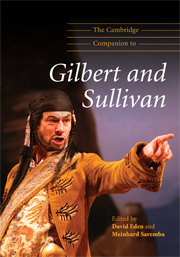Book contents
- Frontmatter
- Part I Background
- Part II Focus
- Part III Reception
- 11 Topsy-Turvy: a personal journey
- 12 Amateur tenors and choruses in public: the amateur scene
- 13 Champions and aficionados: amateur and listener experiences of the Savoy operas in performance
- 14 ‘How great thy charm, thy sway how excellent!’ Tracing Gilbert and Sullivan's legacy in the American musical
- 15 ‘See how the Fates their gifts allot’: the reception of productions and translations in continental Europe
- Part IV Into the twenty-first century
- Appendix 1 Who wrote the overtures?
- Appendix 2 Stage and choral works by Arthur Sullivan and W. S. Gilbert
- Appendix 3 Modern editions of works by Arthur Sullivan and W. S. Gilbert
- Appendix 4 Sullivan's archetypes of English opera
- Notes
- Bibliography and further reading
- Index
- Plate section
12 - Amateur tenors and choruses in public: the amateur scene
from Part III - Reception
Published online by Cambridge University Press: 28 September 2011
- Frontmatter
- Part I Background
- Part II Focus
- Part III Reception
- 11 Topsy-Turvy: a personal journey
- 12 Amateur tenors and choruses in public: the amateur scene
- 13 Champions and aficionados: amateur and listener experiences of the Savoy operas in performance
- 14 ‘How great thy charm, thy sway how excellent!’ Tracing Gilbert and Sullivan's legacy in the American musical
- 15 ‘See how the Fates their gifts allot’: the reception of productions and translations in continental Europe
- Part IV Into the twenty-first century
- Appendix 1 Who wrote the overtures?
- Appendix 2 Stage and choral works by Arthur Sullivan and W. S. Gilbert
- Appendix 3 Modern editions of works by Arthur Sullivan and W. S. Gilbert
- Appendix 4 Sullivan's archetypes of English opera
- Notes
- Bibliography and further reading
- Index
- Plate section
Summary
For all Gilbert's disparagement of amateur tenors and those who sing choruses in public, amateur performances have been the bedrock of the enduring popularity of his work with Sullivan. The Savoy operas have been performed by amateurs virtually since their inception. The Harmonists Choral Society put on HMS Pinafore in the Drill Hall, Kingston upon Thames on 30 April 1879, less than a year after its professional opening. Since then, church halls and schoolrooms across the English-speaking world have resounded on winter evenings to the strains of would-be pirates, policemen, fairies and bridesmaids rehearsing for Spring productions.
Nowadays, Gilbert and Sullivan appeals to amateur performers partly because it is cheap to put on–being out of copyright there are no performing rights fees to pay as there are for most Broadway and West End musicals. It also tends to provide a more substantial role and challenging sing for the chorus than most musicals and requires less complex staging and fewer special effects. These latter factors were also important in its early appeal. As the official history of the amateur operatic movement in Britain notes:
Relatively easy to stage with a good variety of parts, plenty of chorus work and box office appeal, they became instant favourites. The Mikado, The Gondoliers, Iolanthe and the rest of what are known collectively as the Savoy Operas provided the artistic springboards from which most amateur musical groups launched themselves, and indeed, many still do over a century later. No works have played a more important role in developing and sustaining the amateur movement and Gilbert and Sullivan remain the only artists to whose works numbers of societies are specifically designated.
- Type
- Chapter
- Information
- The Cambridge Companion to Gilbert and Sullivan , pp. 177 - 189Publisher: Cambridge University PressPrint publication year: 2009



